Very many of the US military personnel in Europe are supporting operations over large areas outside Europe. Logistics, medical services, etc..If the US defence system pivots to Asia, it becomes less of a land war (like Eurpoe) and more of a sea/litoral war scenario.
So reducing the size of the army aligns with this intent.
There are about 100,000 US troops in Europe, so again this aligns with a withdrawal from the European theatre.
United States Defense Thread
- Thread starter ngatimozart
- Start date
FormerDirtDart
Well-Known Member
Before USAFRICOM was stood up back in '07 USEUCOM split responsibility of Africa with USCENTCOM. So, to stand the HQs up without a lot of growing pain (and to save money) leveraging off the support base in Europe made sense. Also existing in closer timezone does assist in making coordination a tad easier and more responsive,They are, but I’ve never really understood why supporting US forces in, say, Africa is done from Germany rather than CONUS.
downunderblue
Well-Known Member
Topic: Deployment of the 3rd Marine Littoral Regiment (MLR) with NMESIS as part of the Littoral Rotational Force-Luzon
I think this has gone under the radar a bit and worth a post. Last year under Exercise Balikatan 2024, the U.S. Marine Corps' 3rd Littoral Combat Team (which is part of the 3rd MLR) exercised in the northern Batanes islands of Mavulis, Itbayat, and Batan assessing ‘primary training sites for the combined maritime key terrain security operations’.
This year, the full 3rd MLR will deploy as part of the Littoral Rotational Force-Luzon. Since Balikatan 2024 the unit is now equipped the Navy-Marine Expeditionary Ship Interdiction System (NMESIS) – consisting of a Joint Light Tactical Vehicle (ROGUE-Fires Carrier) mounting two Naval Strike Missiles (NSM) each.
The MLR consists of three NMESIS batteries, each of two platoons, each comprising three Medium-Range Missile System Launcher (MMSL) sections. Each MMSL section includes a Leader Vehicle, up to three ROGUE-Fires missile launchers, and a Command and Control (C2) system. My math puts that at 54 NSM’s per MLR without reviewing any capability to reload the launchers.
Also in the Philippines is the US Army Strategic Mid-range Fires System (SMRF)/ Typhon system. The system which mounts a modified Navy SM-6 and/or Tomahawk missiles stayed in country at the end of Balikatan 2024, with a second unit reported to be been deployed for Balikatan 2025. The first unit was sited at Laoag International Airport in Ilocos Norte but is reported to have moved to another location in Luzon (likely remaining in Northern Luzon).
I’ll for now ignore the air/ land attack capability of the Typhon system, but based upon an open source approx. range of 200km for the NSM, below is a graphic showing the operational range when deploying from Mavulis Island (the northernmost of the Batanes Islands). For reference there is only a small PGC station there and deployment is limited, but you get the point regardless. The deployment of NMESIS around the Batanes, inclusive of Itbayat, and Batan, constricts the ability of the PLA-N to independently manoeuvre within or close to the Bashi Channel.
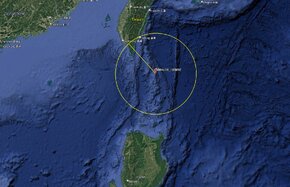
Recent deployments of PLA-N within the Bashi Channel include the both the Shandong and Liaoning regularly transiting. A prime target for the stealthy NSM IMO.
Balikatan 2025 will run from 16APR to 9MAY25 and involve forces from the PH, US, JP and AU along with 16 other observer nations. Per USNI, the Littoral Rotational Force-Luzon "will be forward-deployed in the Philippines for Spring’s Balikatan and Summer’s Kamandag exercises. Compared to Marine Rotational Force-Darwin, another forward-deployed unit in the region, the Philippine force will be headed by the MLR instead of a traditional Marine Air-Ground Task Force ... The new regiments are part of the service’s stand-in force that was developed as part of the Marine Force Design changes built around the idea of creating an island-hopping force to harass warships and other threats in the Pacific".
The 3rd Marine Littoral Regiment (MLR) became was reformed on 4MAR22 in a reported "ceremony that created the first of three such units prescribed by the service’s Force Design 2030 transformation effort. A second MLR is now being formed in Okinawa, with a third planned for Guam".
The unit’s capability was referenced by a Staff Sergent quoted as saying “When we go on the next deployment, we’re going to be pretty disaggregated, seizing key maritime terrain, providing the sensing capability and things like that,” he said. And unlike in Afghanistan and Iraq ... the most challenging thing is going to be [that] we do not have air dominance. I would argue we don't even probably have air superiority, just because of near-peer, and also just going to be like signature management.”
Below is some YT 'war-porn' on the NMESIS if anyone is interested.
Interesting times we live in and worth a post IMO.
I think this has gone under the radar a bit and worth a post. Last year under Exercise Balikatan 2024, the U.S. Marine Corps' 3rd Littoral Combat Team (which is part of the 3rd MLR) exercised in the northern Batanes islands of Mavulis, Itbayat, and Batan assessing ‘primary training sites for the combined maritime key terrain security operations’.
This year, the full 3rd MLR will deploy as part of the Littoral Rotational Force-Luzon. Since Balikatan 2024 the unit is now equipped the Navy-Marine Expeditionary Ship Interdiction System (NMESIS) – consisting of a Joint Light Tactical Vehicle (ROGUE-Fires Carrier) mounting two Naval Strike Missiles (NSM) each.
The MLR consists of three NMESIS batteries, each of two platoons, each comprising three Medium-Range Missile System Launcher (MMSL) sections. Each MMSL section includes a Leader Vehicle, up to three ROGUE-Fires missile launchers, and a Command and Control (C2) system. My math puts that at 54 NSM’s per MLR without reviewing any capability to reload the launchers.
Also in the Philippines is the US Army Strategic Mid-range Fires System (SMRF)/ Typhon system. The system which mounts a modified Navy SM-6 and/or Tomahawk missiles stayed in country at the end of Balikatan 2024, with a second unit reported to be been deployed for Balikatan 2025. The first unit was sited at Laoag International Airport in Ilocos Norte but is reported to have moved to another location in Luzon (likely remaining in Northern Luzon).
I’ll for now ignore the air/ land attack capability of the Typhon system, but based upon an open source approx. range of 200km for the NSM, below is a graphic showing the operational range when deploying from Mavulis Island (the northernmost of the Batanes Islands). For reference there is only a small PGC station there and deployment is limited, but you get the point regardless. The deployment of NMESIS around the Batanes, inclusive of Itbayat, and Batan, constricts the ability of the PLA-N to independently manoeuvre within or close to the Bashi Channel.

Recent deployments of PLA-N within the Bashi Channel include the both the Shandong and Liaoning regularly transiting. A prime target for the stealthy NSM IMO.
Balikatan 2025 will run from 16APR to 9MAY25 and involve forces from the PH, US, JP and AU along with 16 other observer nations. Per USNI, the Littoral Rotational Force-Luzon "will be forward-deployed in the Philippines for Spring’s Balikatan and Summer’s Kamandag exercises. Compared to Marine Rotational Force-Darwin, another forward-deployed unit in the region, the Philippine force will be headed by the MLR instead of a traditional Marine Air-Ground Task Force ... The new regiments are part of the service’s stand-in force that was developed as part of the Marine Force Design changes built around the idea of creating an island-hopping force to harass warships and other threats in the Pacific".
The 3rd Marine Littoral Regiment (MLR) became was reformed on 4MAR22 in a reported "ceremony that created the first of three such units prescribed by the service’s Force Design 2030 transformation effort. A second MLR is now being formed in Okinawa, with a third planned for Guam".
The unit’s capability was referenced by a Staff Sergent quoted as saying “When we go on the next deployment, we’re going to be pretty disaggregated, seizing key maritime terrain, providing the sensing capability and things like that,” he said. And unlike in Afghanistan and Iraq ... the most challenging thing is going to be [that] we do not have air dominance. I would argue we don't even probably have air superiority, just because of near-peer, and also just going to be like signature management.”
Below is some YT 'war-porn' on the NMESIS if anyone is interested.
Interesting times we live in and worth a post IMO.
FormerDirtDart
Well-Known Member
NoThe MLR consists of three NMESIS batteries, each of two platoons, each comprising three Medium-Range Missile System Launcher (MMSL) sections. Each MMSL section includes a Leader Vehicle, up to three ROGUE-Fires missile launchers, and a Command and Control (C2) system. My math puts that at 54 NSM’s per MLR without reviewing any capability to reload the launchers.
A Marine Littoral Regiment consists of:
- Littoral Combat Team : A Marine infantry battalion with a headquarters and service company, three rifle companies and an anti-ship missile battery (NMESIS)
- Littoral Anti-Air Battalion: Headquarters and service company, a mounted Stinger ADA battery, an air traffic control company, a forward arming & refueling point company. In the future an Iron dome battery is planned to be added.
- Littoral Logistics Battalion: Headquarters and service company, two littoral logistics companies and a general support company (w/EOD).
downunderblue
Well-Known Member
I stand corrected.No
A Marine Littoral Regiment consists of:
So among the planned three Marine Littoral Regiments there will be a total of three NMESIS batteries
- Littoral Combat Team : A Marine infantry battalion with a headquarters and service company, three rifle companies and an anti-ship missile battery (NMESIS)
- Littoral Anti-Air Battalion: Headquarters and service company, a mounted Stinger ADA battery, an air traffic control company, a forward arming & refueling point company. In the future an Iron dome battery is planned to be added.
- Littoral Logistics Battalion: Headquarters and service company, two littoral logistics companies and a general support company (w/EOD).
"NMESIS batteries are composed of 18 launchers which are separated into two platoons of nine launchers each. The platoons are further subdivided into three sections of three launchers each. The USMC plans to field 14 batteries of which three batteries will be deployed to MLRs while 11 will be deployed to the CONUS in support of rotational MEU deployments".
So 18 NSM's per battery and one battery per LCT and thereupon the MLR.
It's still significant.
I checked and they can be reloaded, provided you have sufficient equipment/ logistic chain. It does look like a substantial effort though (see pic) but where there is a will there is often a way.
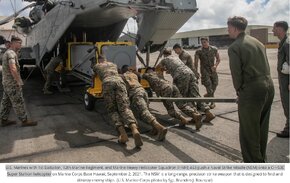
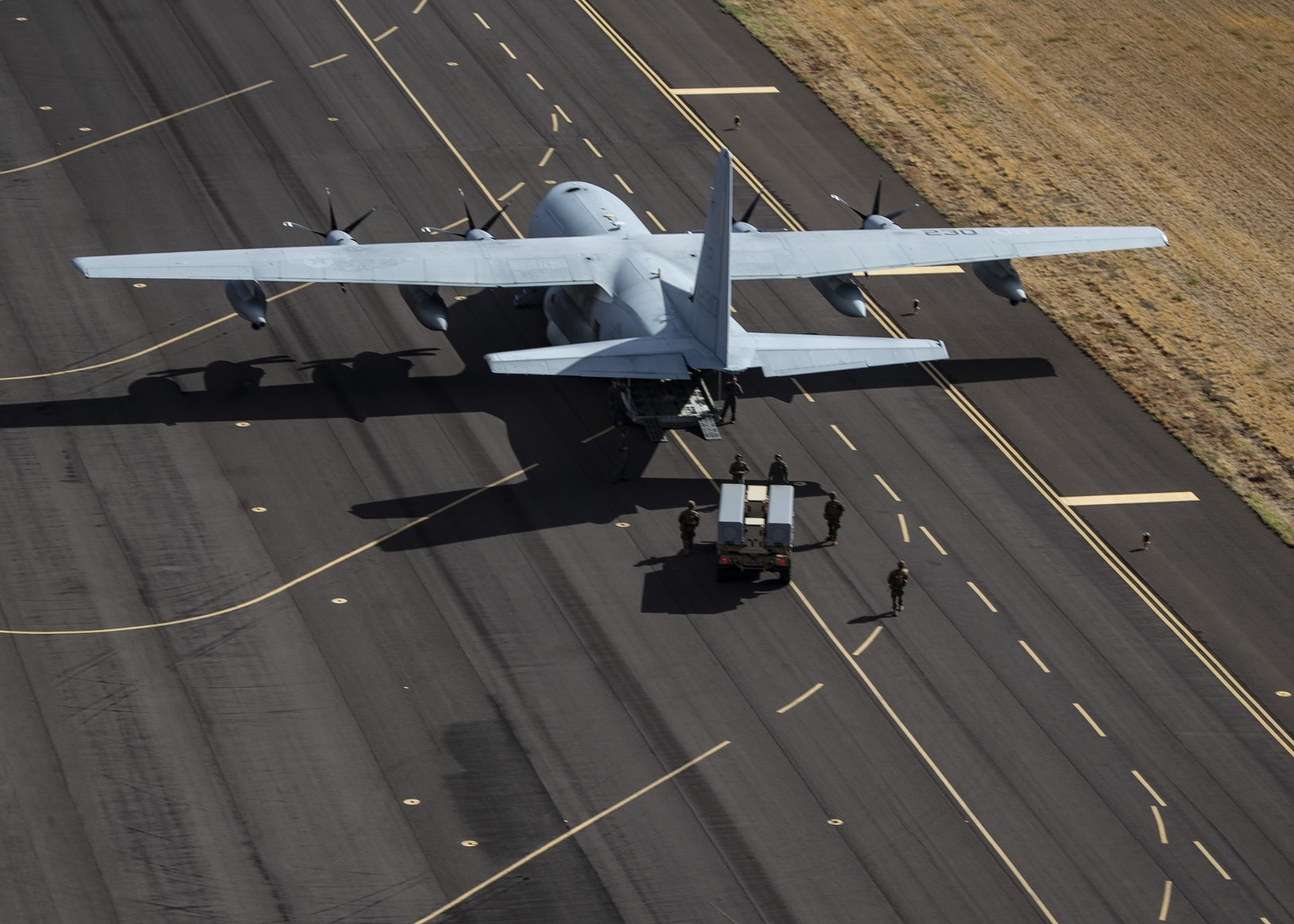
USMC NMESIS and Naval Strike Missiles Logistics Explained - Naval News
The “tyranny of distance” problem in the United States Indo-Pacific Command (INDO-PACOM) region, dotted with numerous small islands, forms the basis of the U.S. Marine Corps’ (USMC) strategy of Expeditionary Advanced Base Operations (EABO) of establishing ad-hoc bases on land and sea and...
Big_Zucchini
Well-Known Member
Lots of investments into Defense Industrial Base instead of plain procurement. This is exactly what the US needs right now.
Golden Dome also gets a $25 billion boost, which is a good initiative IMO. Should be possible to replicate some of these for theater defense.
Golden Dome also gets a $25 billion boost, which is a good initiative IMO. Should be possible to replicate some of these for theater defense.
John Fedup
The Bunker Group
RR is exempt from tariffs on its jet engines. I guess some accountant explained to the IOTUS how much more money would be required for the DoD to fund its engine requirements with tariffs in place.

 www.airforce-technology.com
www.airforce-technology.com

Tariff Watch: US decides to exempt Rolls-Royce engines - Airforce Technology
In the new US-UK trade deal, Rolls-Royce engines will be exempt from the baseline tariff of 10% originally imposed on the UK.
John Fedup
The Bunker Group
This article discusses the high demand for TNT and nitrocellulose needed for shell production. According to this article, no TNT is currently made in the US (plant coming to Kentucky) and most nitrocellulose is imported. Wasn't aware Canada produces 5,000 tons a year. As Trump says he needs nothing from Canada, Canadian production should go to Ukraine and friendly NATO allies.
Shell Game: Inside The Worldwide TNT Shortage
Shell Game: Inside The Worldwide TNT Shortage
John Fedup
The Bunker Group
This article suggests the need for Space Force to have 25% of the defence budget for the next 5 years, unaffordable IMHO unless huge cuts occur elsewhere. A gift proposal for Musk perhaps? Maybe nuke generated EMP and everyone can operate in the dark would be cheaper.

 breakingdefense.com
breakingdefense.com

Space Force should get a quarter of Pentagon spending, if DoD is serious about countering China - Breaking Defense
Christopher Stone in this op-ed argues that since China sees Space as the most important domain, the US should give more money to the Space Force.
Todjaeger
Potstirrer
I am still waiting for the United States Space Force Academy to be established and TBH it should be located within the Presidio and nearby Marin County in California.This article suggests the need for Space Force to have 25% of the defence budget for the next 5 years, unaffordable IMHO unless huge cuts occur elsewhere. A gift proposal for Musk perhaps? Maybe nuke generated EMP and everyone can operate in the dark would be cheaper.

Space Force should get a quarter of Pentagon spending, if DoD is serious about countering China - Breaking Defense
Christopher Stone in this op-ed argues that since China sees Space as the most important domain, the US should give more money to the Space Force.breakingdefense.com
Of course one would wonder just what those making recommendations consider to be part of the DoD budget, given that a number of US gov't/security agencies have space assets (hello, NRO?)
Terran
Well-Known Member
Sadly given the current real estate market, I doubt the U.S. DOD has the budget nor San Francisco the interest in loosing Fort Baker to establish Starfleet Academy. We just going to have to wait a century. Right now the USAF and USSF are playing the Annapolis model of two services one school.
Don’t get me wrong, I feel that as the first “Space force” the USSF should go balls deep and revel in the camp.
Don’t get me wrong, I feel that as the first “Space force” the USSF should go balls deep and revel in the camp.
FormerDirtDart
Well-Known Member
Deleted
John Fedup
The Bunker Group
A summary of RDT&E for the US military. Seems the F/A XX 6th gen fighter is in trouble based on limited funding. Given the limited range range of naval fighters (and rumoured minimal range increase for the new fighter), carriers will be at increased risk as newer missiles emerge. This in turn may limit the Ford class fleet size eventually. The F-47 won't get funding for an advanced engine and no new funding for future tankers. Doesn't seem prudent given the vastness of the Pacific.
EXCLUSIVE: Pentagon's RDT&E budget revealed - Which next-gen systems get a cash influx in FY26? - Breaking Defense
EXCLUSIVE: Pentagon's RDT&E budget revealed - Which next-gen systems get a cash influx in FY26? - Breaking Defense
Sandhi Yudha
Well-Known Member
|"He told reporters Friday that he finalized the decision after "talking about it for months" and asserted the original name was only changed because the government at the time went "woke.""|
Trump signs executive order rebranding Defense Department as Department of War
Well, at least it hasn't become "Department of Offense".
Trump signs executive order rebranding Defense Department as Department of War
Well, at least it hasn't become "Department of Offense".
John Fedup
The Bunker Group
The government is broke, not woke. BTW, broke has a double meaning here, needless to say. 
MARKMILES77
Well-Known Member
The new Trump "National Defence Strategy" is almost done and leaks are beginning to come out.
It appears the US will no longer aim to counter China as it's main threat and instead will focus on domestic issues and
problems in the Western Hemisphere. Nor will countering Russia be a priority.
If true will have profound consequences for Taiwan, particularly, but also South Korea, Japan, Phillipines and even Australia.
Will AUKUS continue to be important to the US if China is no longer the priority?
Will also have big domestic political implications. China Hawks are a powerful voice in the Republican party.
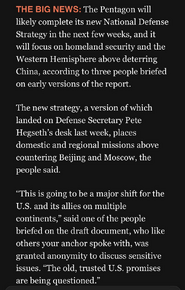
It appears the US will no longer aim to counter China as it's main threat and instead will focus on domestic issues and
problems in the Western Hemisphere. Nor will countering Russia be a priority.
If true will have profound consequences for Taiwan, particularly, but also South Korea, Japan, Phillipines and even Australia.
Will AUKUS continue to be important to the US if China is no longer the priority?
Will also have big domestic political implications. China Hawks are a powerful voice in the Republican party.

MARKMILES77
Well-Known Member
Seems Colby has his hands in a lot of pies.

 www.intellinews.com
www.intellinews.com
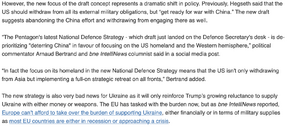


US to draw back from Asia in new defence policy concept
The United States is scaling back its strategic focus on Asia, marking a potential end to over a decade of military and political efforts to ...


